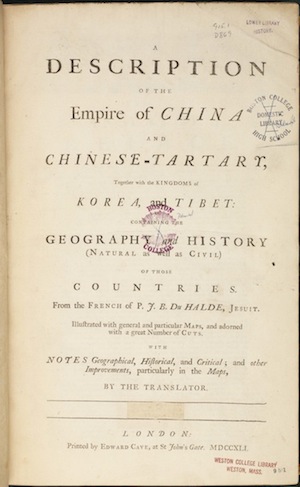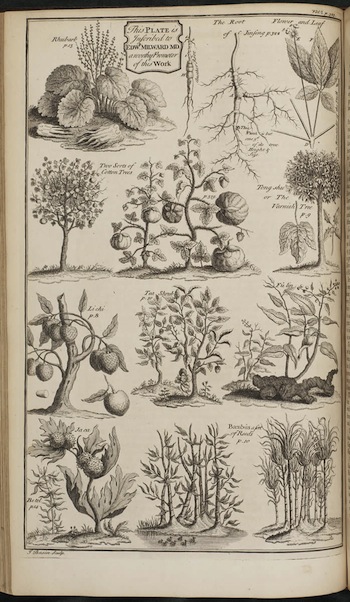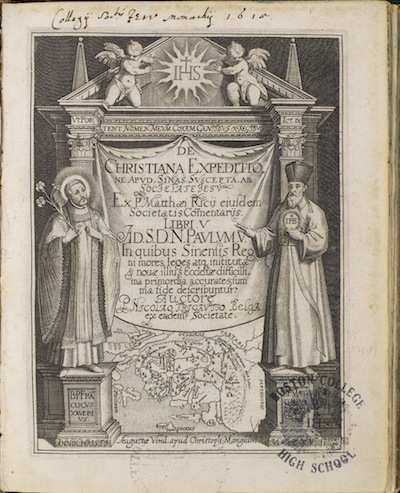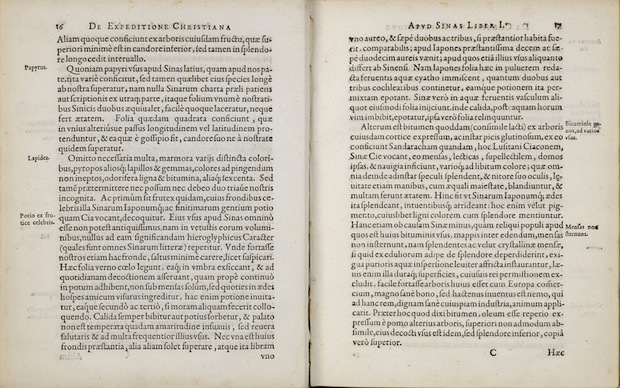|
|||||||||||
|
FEATURESTea JesuiticaCompiled by Jeremy Clarke, SJ
|
Tea shrub, its different sorts |
If from Trees we pass to shrubs, those which bear the Tea ought to be places in the first Rank, because they are of the greatest use and benefit in China. The Name of Tha, [or Tea] comes to us from the corrupt Pronunciation at Tswon-chew, and Chang-chew-fû, in the Province of Fo-kyen; in all other Parts of the Empire they use the Word Cha, as do the Portugueze in their Relations. But ths Word comprises many kinds of Tea, consider'd according to the different Names given to it in different Provinces. However, it may be distinguished, by its Qualities, into four Sorts, viz. Song-lo-cha, Vû-i-cha, Pû-eul-cha, and Lo-ngan-cha. |
Song-lo, or Green-Tea |
 Fig.3 Title page of the English translation of Du Halde's Description The first Sort is so call'd from a Mountain in the Province of Kyang-nan and District of Whey-chew-fû, in the Latitude of 29 d. 58 m. 30 f. This Mountain bears the name of Song-lo-shan; it is neither high nor of great Extent, but cover'd over with these Shrubs, which are cultivated on its Sides, in the same manner as at the Foot of the neighbouring Mountains. Song-Lo, which we call Green-Tea, is planted much in the same manner as Vines, and its Growth is prevented, otherwise it wou'd run up to 6 or 7 Foot in height: It must also be planted anew every 4 or 5 Years, or else the Leaves will become thick, hard and rough. The Flower is white, and shap'd like a Rose of 5 Leaves. In Autumn, when the Flower decays, there appears a Berry in the form of a well-fill'd Nut, somewhat moist, and not ill-tasted. What I have spoken of the Height of these Shrubs, must be understood of those that grow in the Province of Kyang-nan; in other Parts they let them grow to their natural Height, which is 10 or 12 Feet; for this reason, when the Branches are young, they bend them down, that they may gather the Leaves with greater ease. The Song-lo-cha, preserved several Years, is and excellent Remedy against Distempers. |
Vû-i, or Bohea-Tea |
The Vû-i-cha grows in the Province of Fo-kyen, and takes it [sic] Name also from the famous Mountain Vû-i-shan, situated in the District of Kyen-ning-fû, and two Leagues distant from the little City of Tsong-gan-hyen, in 27 d. 47 m. 38 f. Latitude, according to the Observations made on the Spot. This is the most famous Mountain in that Province: It is cover'd with a great Number of Temples, Houses and Hermitages of the Bonzas belonging to the Sect of Tau-kya, which draw thither a great Concourse of People. The better to compass their Design of making this Mountin pass for the Abode of the Immortal Beings, they have convey'd Barks, Chariots, and other Things of the same Kind, into the Clefts of the steepest Rocks all along the Sides of a Rivulet that runs between; insomuch that these fantastical Ornaments are looked upon by the stupid Vulgar as a real Prodigy, believing it impossible that they could have been raised to such inaccessible Places, but by a Power more than human; the Soil of the Mountain which produces this Plant is light, whitish and sandy. The Shrubs Vû-i-cha and Song-lo-cha are of the same Height and Size, and cultivated in the same manner; the only Difference between them is, that the Leaves of the latter are more long and pointed, give the Water a greenish Tincture, and Experience shews it to be somewhat raking. On the contrary, the Leaves of the Vû-i-cha are short, more round, somewhat blackish and colour the Water yellow, without the Harshness, or any Quality offensive to the weakest Stomach: Hence the Vû-i-cha is most generally used throughout the Empire. 'Tis difficult to meet with any that is good in the Northern Provinces, where usualle that only which consists of the large Leaf is sold; for the more yellow, tender and fine the Leaves of the Vû-i-cha, as well as those of the Song-lo, are, the more they are esteemed: Of these they make three sorts in Places where Tea is gathered. |
Mau-cha, or Imperial-Tea |
The first is the Leaf gathered from the Shrubs newly planted, or, as the Chinese express it, are the first Points of the Leaves: This they call Mau cha; and is scarce ever used but in Presents, or to send to the Emperor. The second is of the Leaves more fully grown; this is what they sell by the name of good Vû-i-cha. The remaining Leaves, which are allwed to grow to their full Bigness, make the third sort, which is very cheap.  Fig.4 An illustration from the Description featuring the 'Tea Shrub' in the centre of the third row. There is yet another sort made of the Flower itself, but those who would have it must be speak it, and pay an excessive Price. The Missionary Geographers, having got a little of it by means of the Mandarins, had it prepared twice or thrice after the usual manner, but found no sensible Change in the Water, either as to Colour or Taste, which is probably the Reason why this Tea is not used by the Emperor or even in the Palace. The Mau-cha above-mentioned is the Imperial Tea, and sold in the Places near the Mountains Song-lo and Vû-I, for Forty or Fifty Sols a Pound [about two Shillings English.] Under these two sorts of Tea or Cha, we may comprehend all the rest, distinguished by different Names, as Lû-ngan-cha, Hay-cha, &c. The first has its Name from the City of Lû-ngan-chew, although the best Tea of this kind is cultivated no where but on the Sides of the little Hills belonging to the small City of Ho-shan-hyen, from whence they are distant about seven Leagues. The Missionaries, having examined it on the Spot, found no Difference between it and the Song-lo-cha, either in the Figure of the Leaves or the manner of Cultivation. If it tinges the Water of a different Colour, and when fresh appears not quite so rough or corrosive to the Taste, it may be attributed to the difference of Soil, which has a sensible Effect on several Plants; since we see in Europe, that Wines of the same kind of Grape are more or less rough in different Parts of the same Province, and in Provinces more distant the Alteration is still more perceptible. The Chinese however find the Effestc of them very different: The Song-lo is hot and raking, while the Lû-ngan Tea is not, and besides is so tempered that it is neither hot nor cold, and is reckoned very wholesome. The Hay-cha come from Kan-chew-fû in the Province of Kyang-si, and differs in no Respect from the Lû-ngan-cha, not even in its Roughness or Smoothness upon the Palate, so that it may be called a Species of the Song-lo-cha. 'Tis the same with the other sorts of Tea; for instance, that which the Mongols in Tartary use, called by the Kayel cha or Karcha, consists only of Leaves, either of Song-lo or Vû-i-cha, which grow to their full Size, and are mixed without any sorting; because the Chinese think any thing is good enough for the Tartars, who cannot distinguish the coarse Tea from the Fine, and commonly dilute it with Milk; of this they make bothan agreeable and a nourishing Liquor, which they take at any Hour of the Day. |
Counterfeit Teas |
But we must not confuse every thing which the Chinese call Cha with the true Tea; for they give that Name to Plants that do not deserve it, and which are indeed otherwise denominated by those who have not Interest enough to make them pass for such. Thus in the Province of Shan-tong, that which is sold by the Name of Meng-ing-cha as admirable Tea, is properly no more than a kind of Moss, which grows on the rocky Parts of a Mountain belonging to the City of Men-ing-hyen. It is of a very bitter Taste; and has this Quality of the true Tea, that, when drank hot after Meals, it promotes Digestion. The same sort of Tea is found in some parts of the Provinces which are more Northerly than Shan-tong; though it be not made of Leaves, yet the Merchants call it Cha-ye, or Leaves of Tea. In those Countries where the Tea does not usually grow, the common People, who have not the nicest Palates, make use of any thing that resembles the Tea, either in Taste or Effects, and regale themselves upon this coarse Stuff, which they frequently gather from Trees, that, having been long transplanted, degenerate on account of the improper Soil, which does not agree with them; and to make it come cheaper, they lay in their Store when the Leaves are grown old, and become tough and large, which renders the Taste rough and insipid, although it produces the same Effects in those who take it, as the Song-lo or Vû-I Tea. The third sort of Tea is that which we have named Pû-eul-cha, or Tea of the Village Pû-eul, which is situated in the Province of Yun-nan, and on the Borders of Pegu, Ava, the Laos and Tun-king. Its Neighbourhood to the Mountains, which produce this kind of Tea, has invited the Merchants thither, and by this means it is become considerable; though the Inhabitants debar any Merchant from approaching nearer than the Foot of the Mountains, where they receive the Quantity of Tea for which they have bargained. From these Merchants we learned that the Trees which produce this Tea are tall and bushy, planted without Order, and propagated without Culture; the Leaves are longer and thicker than those of the Song-lo-cha and Vû-i-cha, and are roll'd up into a kind of Balls, which they sell at a good Price. This sort of Tea is common in the Provinces of Yun-nan and Quey-chew; but the Taste is disagreeable, tho' smooth. The Balls, when cut in pieces, they throw like other Tea into boiling Water, to which it gives a reddish Tincture. The Chinese Physicians affirm this Drink to be wholesome, as by its Effects it seems to be: The Missionaries, and those who accompanied them, found it very good in slight Disorders, inevitable in long Travels, especially in the excessive Heats of Summer; but its peculiar Qualities are, that it cures the Cholick, stops the Flux, and creates and Appetite; but then it ought to be drank as strong again as Tea is commonly made. |
Related material from China Heritage Quarterly:
Notes:
*The translation is Louis Gallagher's and is taken from his China in the sixteenth century: the journals of Matteo Ricci, 1583-1610, New York: Random House, 1953, pp.16-17.
†From the 1741 English translation, probably made by Emanuel Bowen, and published by Edward Cave in instalments under the title A Description of the Empire of China and Chinese-Tartary.

